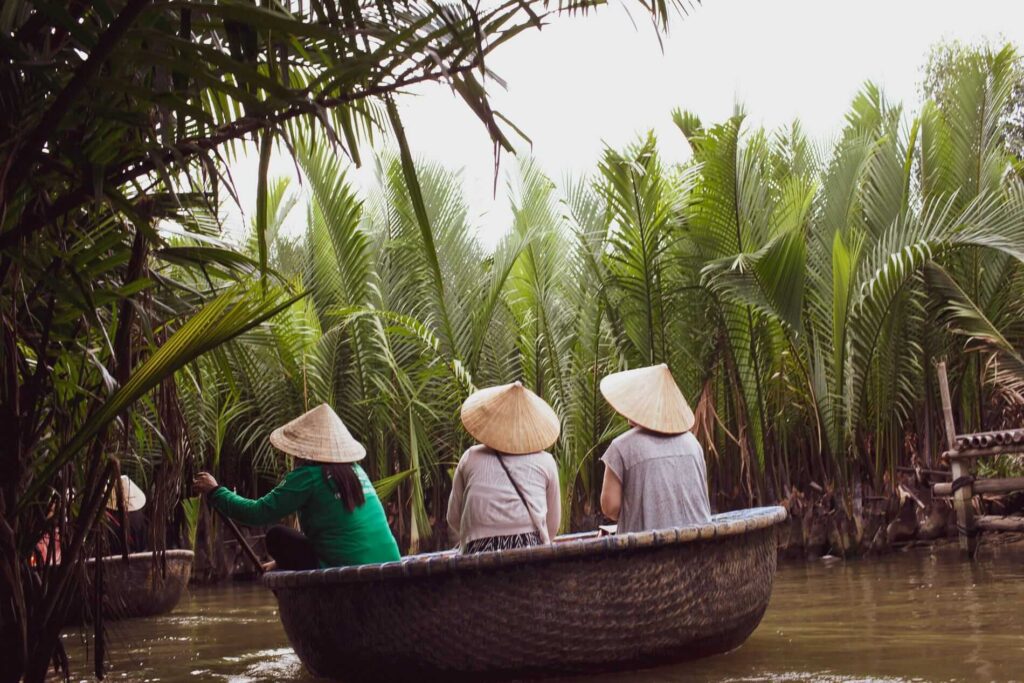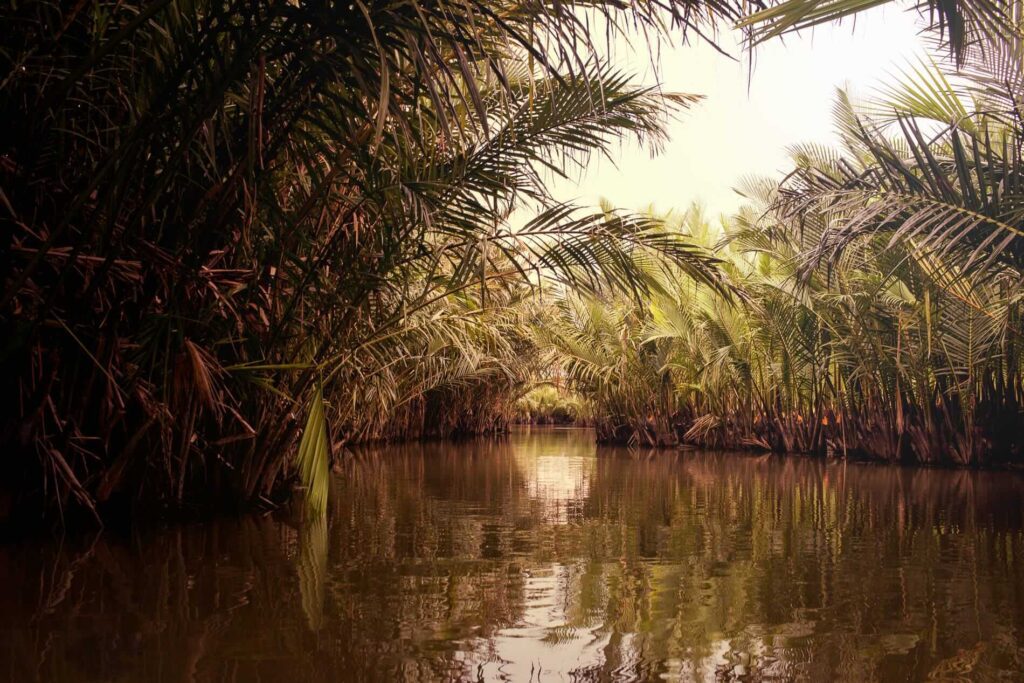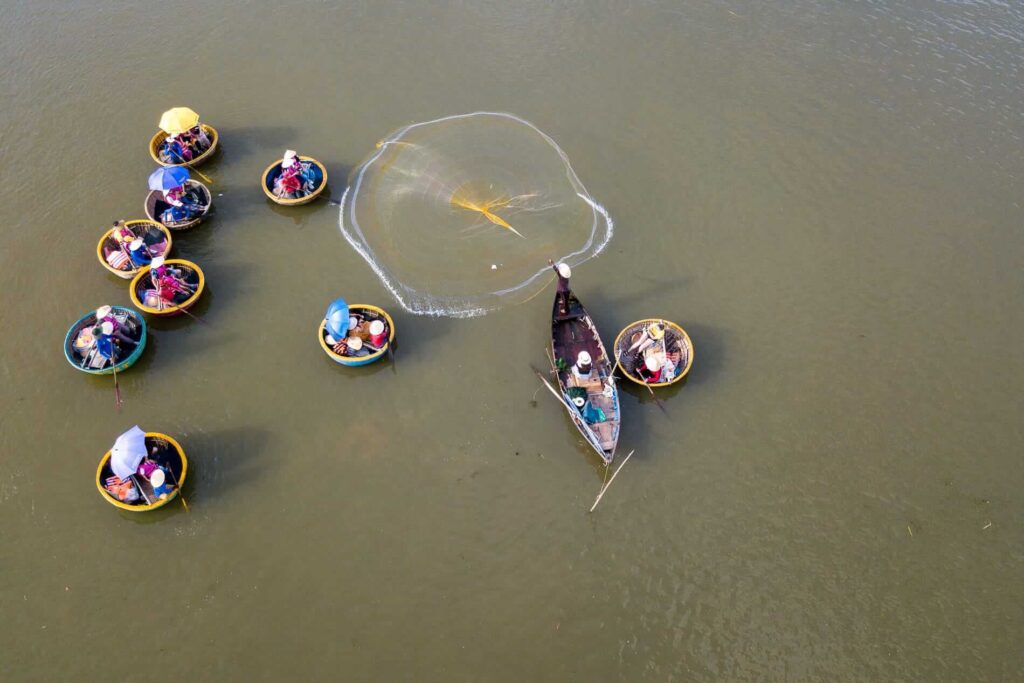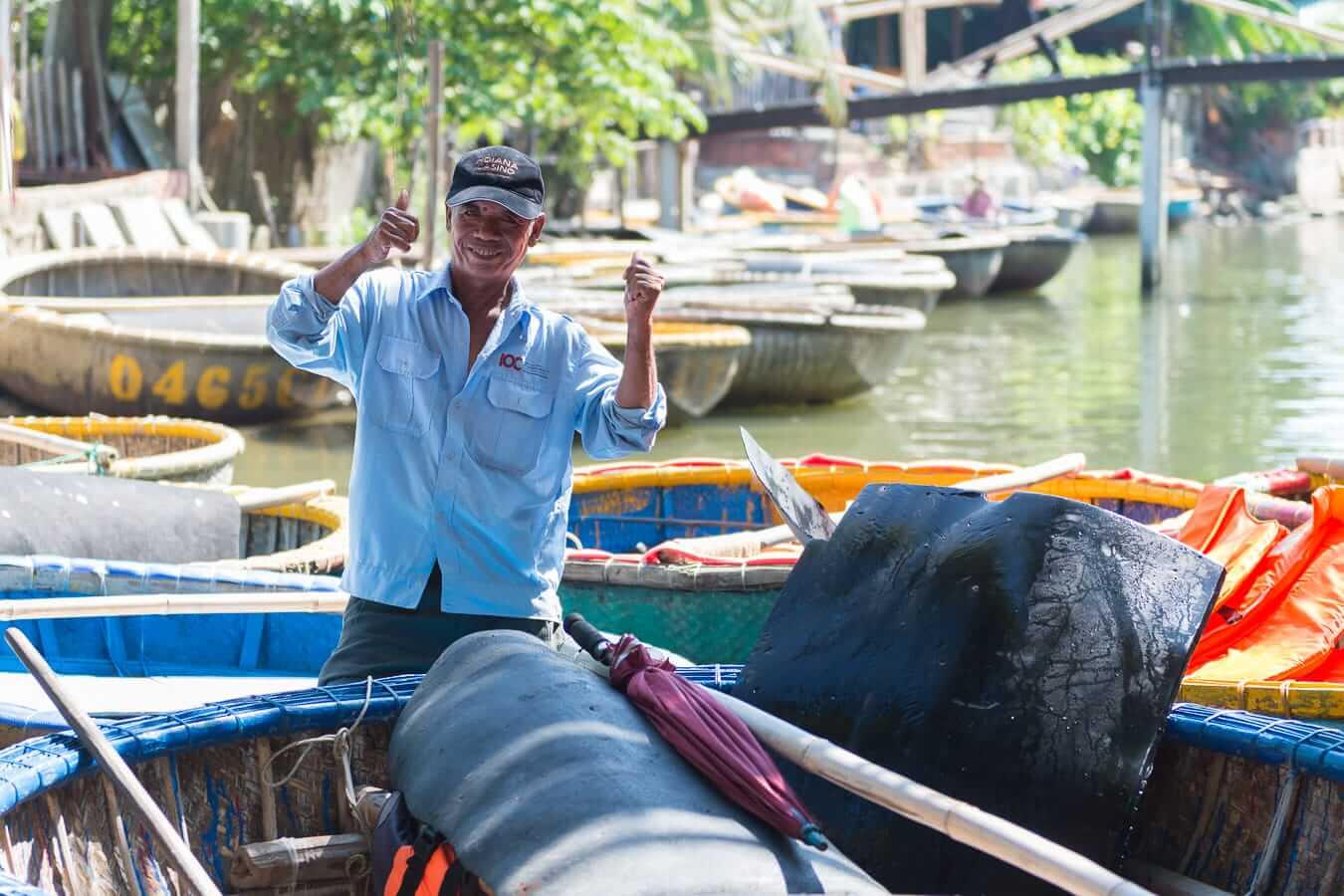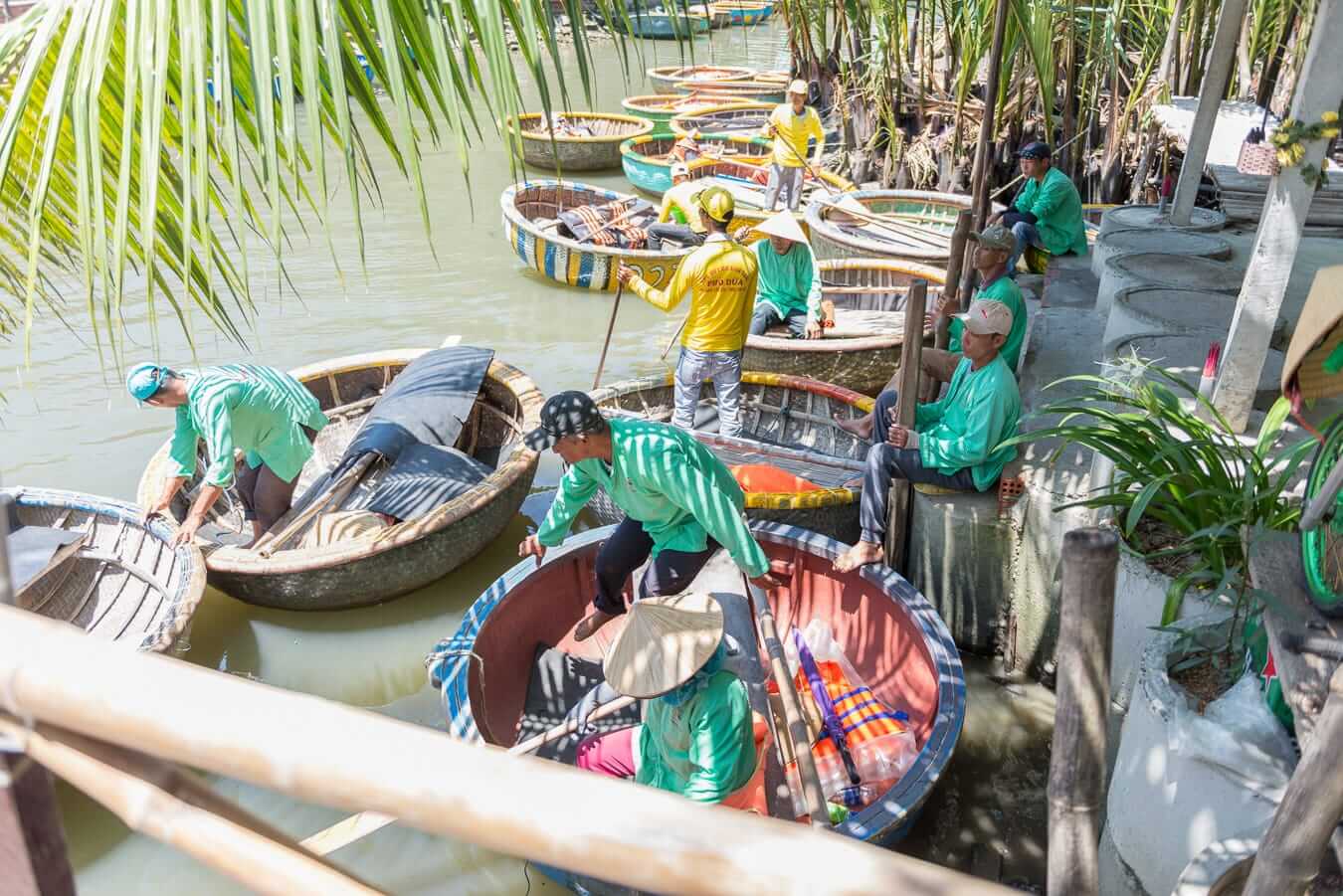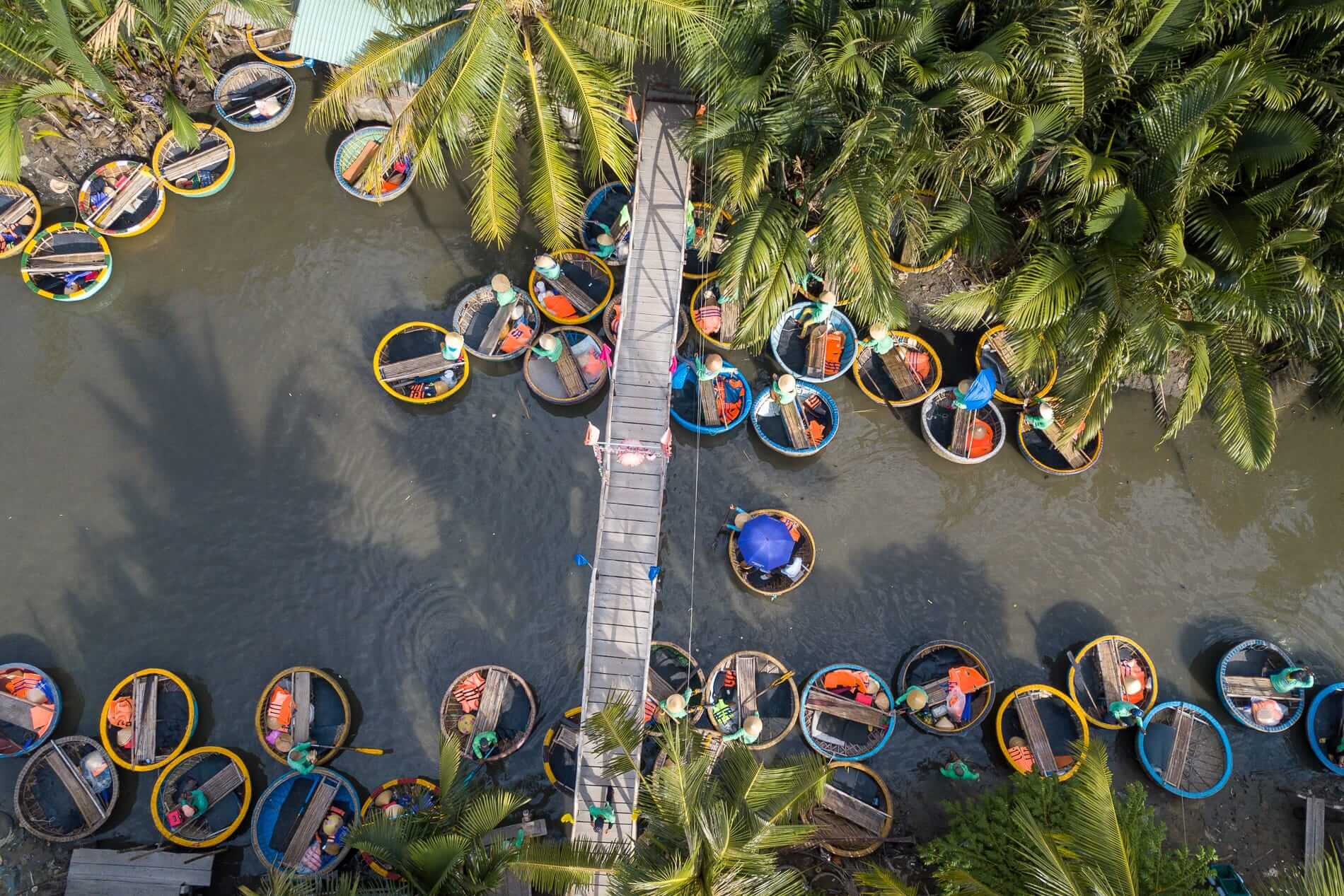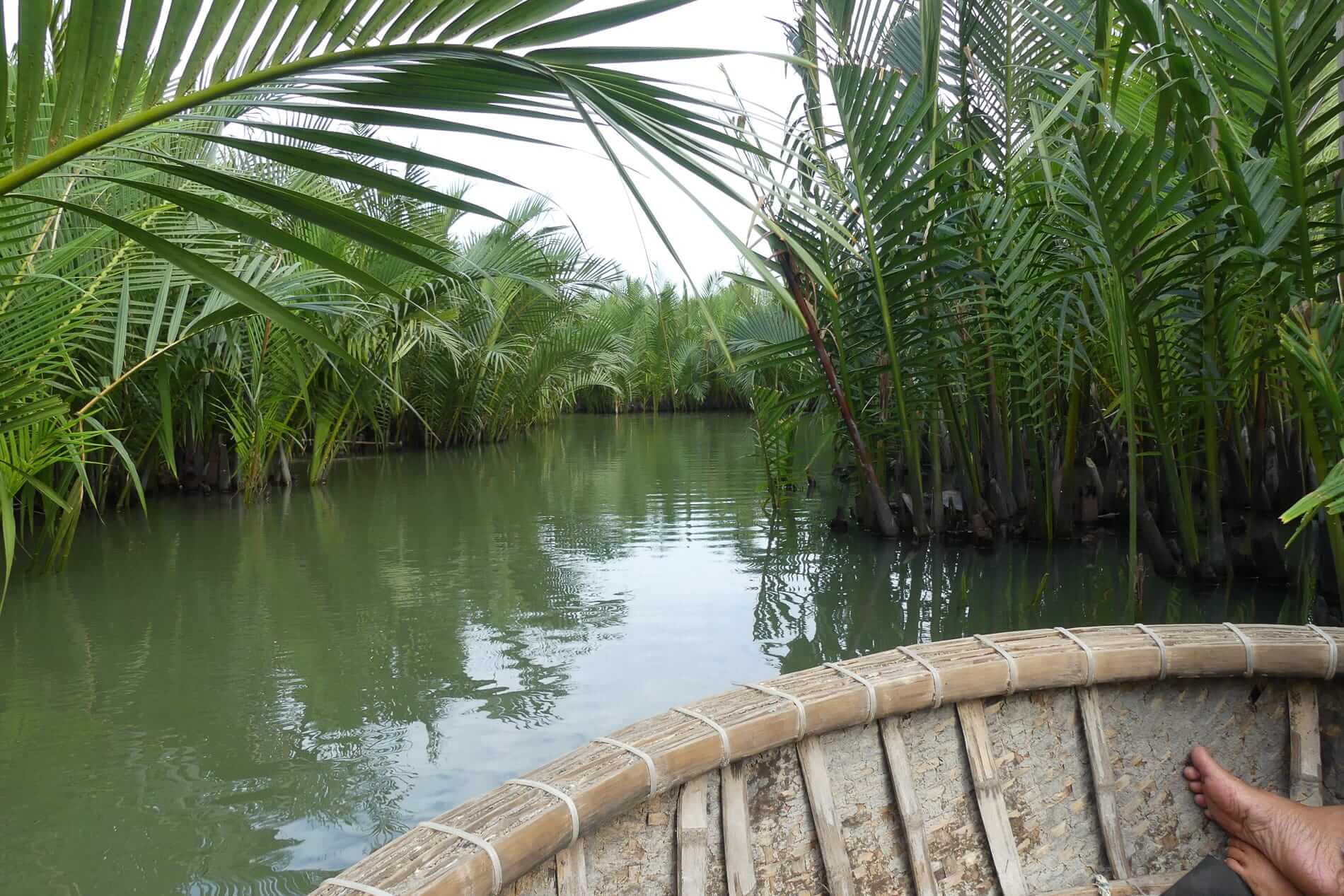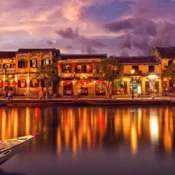
Basket Boat Rides at Hoi An’s Coconut Village
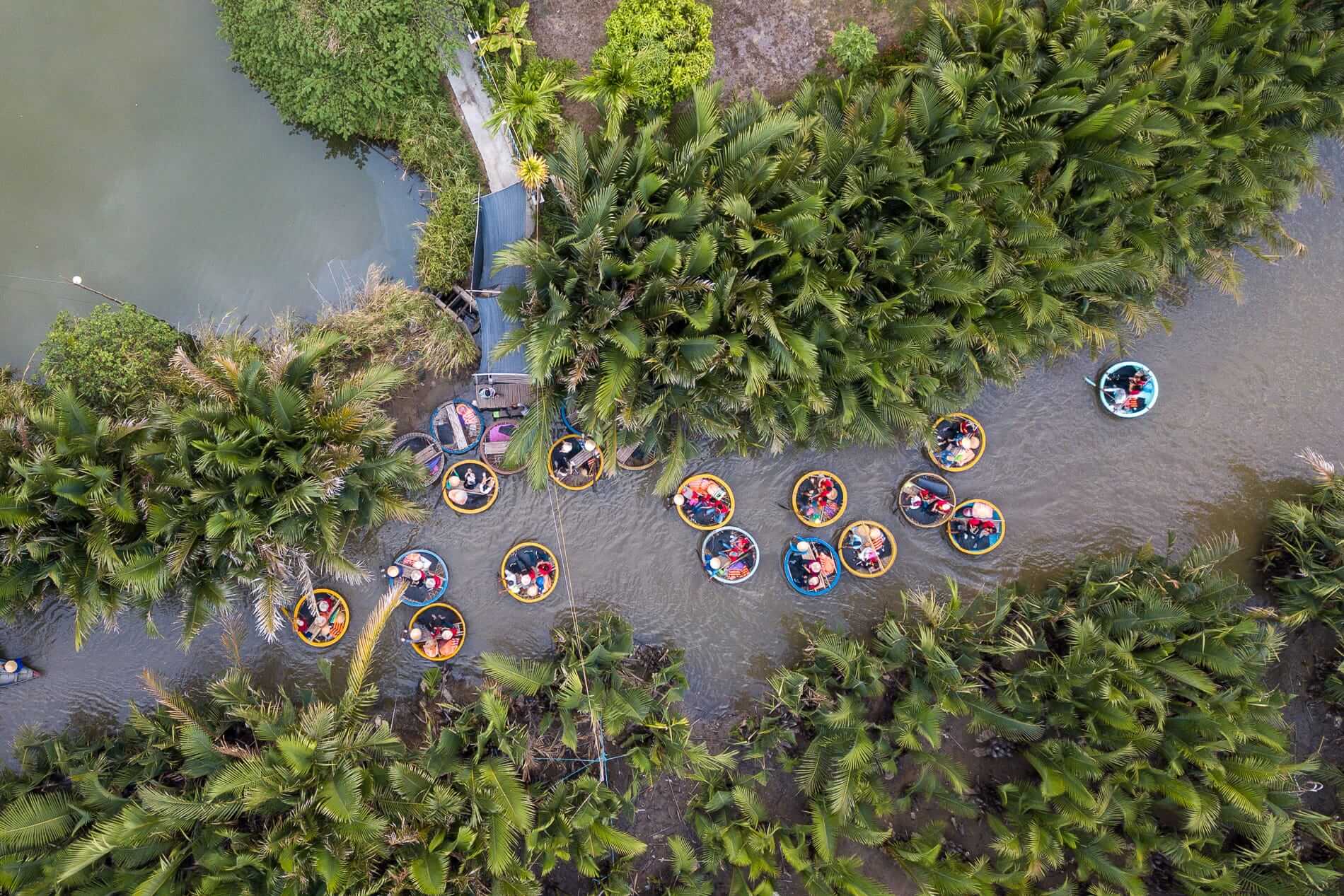
Basket boats float through the coconut palms at Cam Thanh Coconut Village
Had your fill of Hoi An Old Town’s shops and markets, and sunbathing at Cua Dai Beach is just too tranquil? Then enjoy a basket boat ride at the Coconut Boat Village Hoi An in-between.
Legend has it Vietnam’s basket boats originated as a way for local fishermen to avoid paying taxes imposed during the French colonial rule. Others say the boats were born out of necessity as they were more practical than traditional fishing boats.
Whichever the case, the basket boats have become an endearing symbol of life along the central and southern Vietnamese coast for business, pleasure, and now tourism. Nowhere is this more evident than in Cam Thanh, also known as Hoi An’s Coconut Village or more informally, the Coconut Boat Village, just a few kilometres east of Hoi An’s Old Town.
In this article, Hidden looks into experiencing a basket boat ride yourself. Where a local guide skippers you through the eight-hectare network of water coconut palms, onboard a sturdy, all-natural vessel. It won’t leak, capsize, or have you swimming for shore. It’s fun for the entire family. So keep reading to find out the history of the boats themselves and the best way to experience the Coconut Boat Village in Cam Thanh.
History of the Basket Boat
France took control of Vietnam following the Sino-French War in 1884-85. At the time, fishing was an important part of the country’s welfare. Therefore the French, seeking to fatten their coffers, imposed a tax on all fishing boats. The Vietnamese, who were far from wealthy, then designed the spherical basket boat which they claimed wasn’t a boat at all, but a basket. The government reluctantly agreed and the local fishermen were spared any tax.
This is the generally accepted story behind the origin of the boats. However, others say the basket boat was built simply because it was a more effective fishing vessel with superior stability, strength, and maneuverability which is true regardless of the boats’ origins. They sit atop the water moving with it, avoiding waves versus most boats which slice through the water.
Today’s Basket Boat
The basket boat maintains its original design and composition today using bamboo and cow dung along with a waterproof resin from tree sap to keep it afloat. Firstly, young and flexible bamboo is dried in pieces. Then it is cut to an exact size before being woven together by hand, forming the shell of the boat. Many boat builders use cow dung or a water-resistant resin to waterproof the boat then cover it with tree sap. The boat is left in the sun to dry, adding strength. It’s then ready for action.
Yes, there are variations of it in the shape of typical modern-day vessels, including the use of fibreglass. But these traditional, bouncy little round boats are still alive and well, thriving, in Hoi An’s Coconut Village. So much so, there are up to a thousand in the water at any one time.
The Basket Boat Ride at the Coconut Village
At first glance, a basket boat might appear unstable but that is certainly not the case. The boats’ spherical shape distributes weight evenly. With a local skipper on board when you board, there are few of the wobbles common when stepping on to most small boats. Each one seats three adults comfortably on a built-in bamboo bench which stretches across its centre.
The boats measure about two metres in diameter so there’s plenty of room for your bags, shoes, camera and more. Most boat operators won’t let more than two adult passengers on board, though a toddler and a baby, or two, are excepted. Life jackets, while mandatory but loosely enforced, are available should you feel safer wearing one. Bear in mind that your skipper may receive a hefty fine if you do not wear a life jacket.
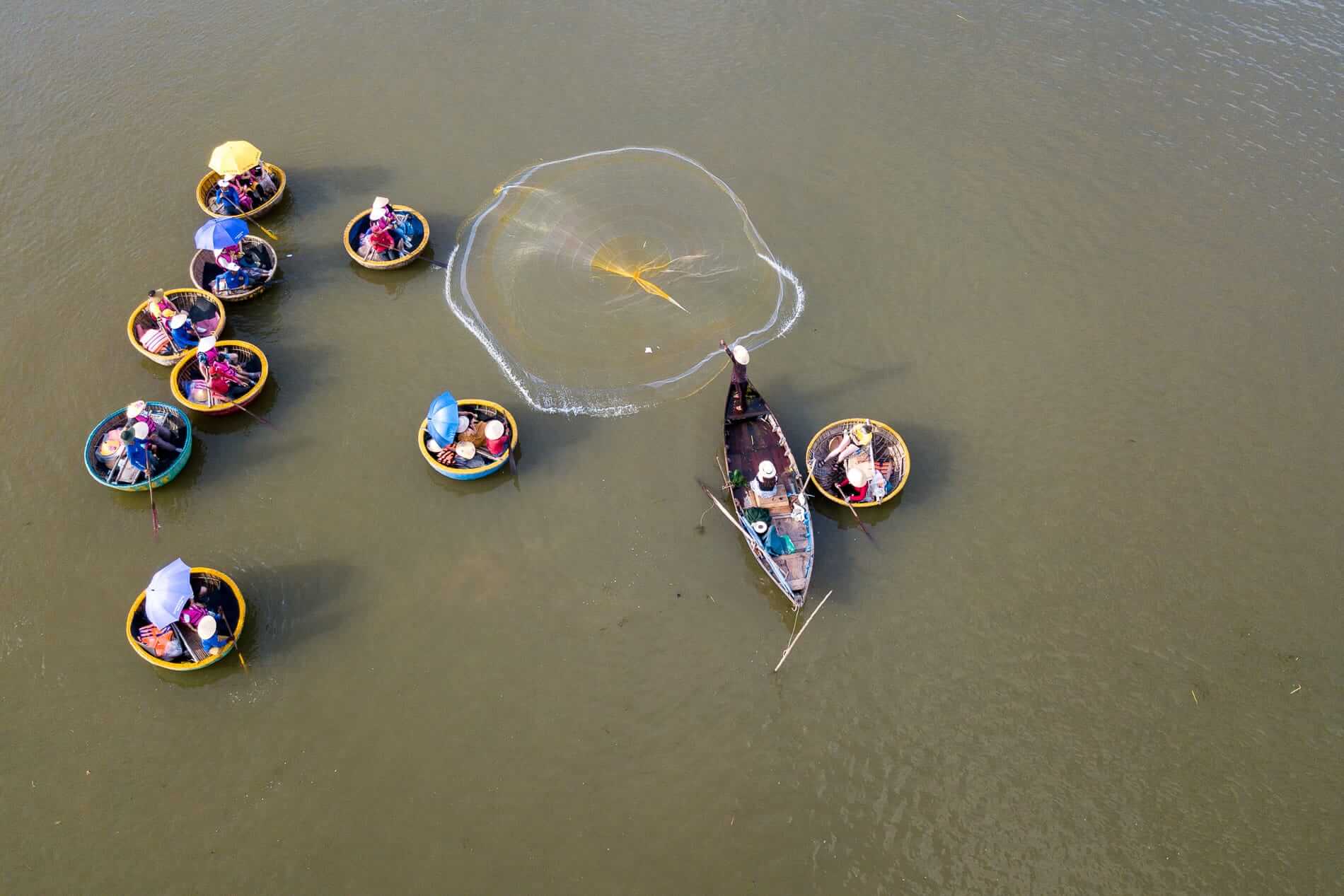
Little round boats look like toys when seen from the air
The Coconut Boat Ride Experience
After boarding at the river bank, the guide takes you on a 45-60-minute ride on the Cua Dai River, meandering through its at times maze-like network of channels, canals, and coconut palms. The water is calm and the boats move surprisingly fast despite guides using a small, single paddle. There are stops along the way for photos and a staged, though entertaining, demonstration of speed and balance by a local boat skipper. You also have the chance to throw a traditional fishing net (but don’t expect to catch anything) and paddle the boat. In addition, enjoy the quick and creative hands of your guide in turning palm stem strips into beautiful origami.
Hoi An isn’t known for its abundance of kids’ activities, but a basket boat ride is a good one. Kids of all ages will have a blast on the basket boats weaving through the palms, enjoying the entertainment, and marveling at the skills of local guides. Even with short attention spans, they won’t find the hour-long journey a drag.
Cam Thanh Coconut Village
A former army base during the American war, Cam Thanh, or the Coconut Village, is six kilometres east from the heart of Old Town. Don’t confuse this with the Cam Thanh district that stretches from the eastern edge of Hoi An to the Cua Dai Beach peninsula. It’s an easy drive by car or motorbike, and, if you go early or late, a flat and manageable bike ride. Expect it to take ten minutes by motorized transport or 30 minutes by bike.
The uniqueness of the Coconut Boat Village is its palm trees known as nipa, or mangrove, palms. Or, more commonly for visitors, water coconut palms. These are the only members of the palm family which have successfully adapted to mangrove ecosystems. They grow in soft mud and areas of slow-moving tides and in rivers with roots submerged; only the stalks and leaves are above water.
These dense palms provide shelter from the monsoon storms and floods as well as providing a home for birds and many species of aquatic animals. The palm’s fruit is a tasty snack or dessert and the palm leaves are used to thatch roofs throughout the village.
The Coconut Village and Bamboo Village
The Coconut Boat Village is really two parts: Coconut Village and Bamboo Village. The latter about five hundred metres south on Cau Cua Dai, the main road which passes the village, or fifty metres as the crow flies, or boat paddles. The village is, well, a village; not an amusement park or exhibit, with families living and working in businesses there. There are restaurants and shops but neither in any great quantity as the prime activity is the basket boat rides. There are no hotels, resorts, spas or other services to speak of.
Of Cam Thanh’s two parts, the Coconut Village in Hoi An is the busier of the two with a greater concentration of basket boat tour operators. Bamboo Village is a little tidier, better maintained and easier to access, particularly if you have a vehicle. Both consist of a pedestrian pathway but expect frequent beeps to move over from motorbikes. Both locations have public restrooms.
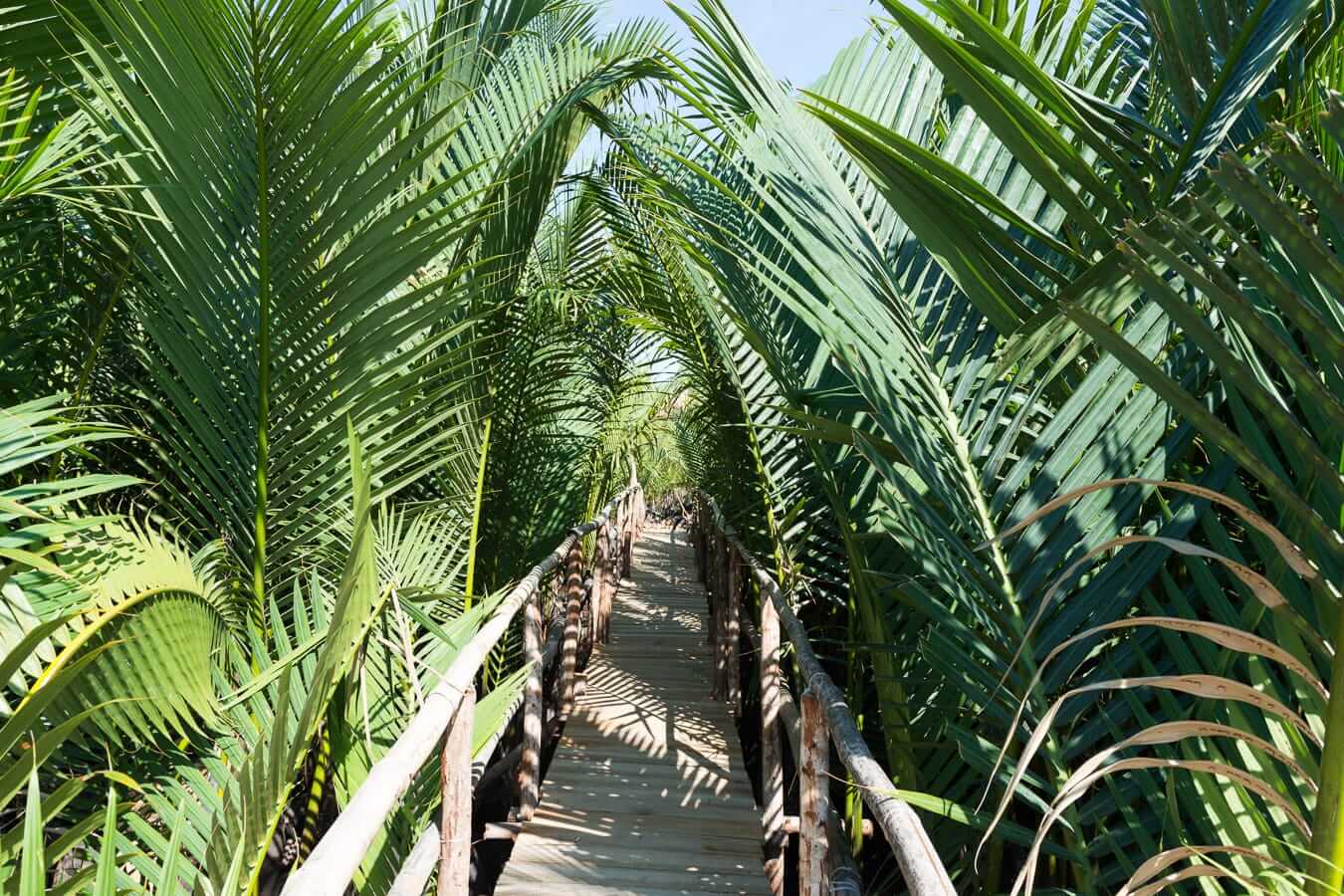
Bamboo walkways through the palm trees. Photo: Anna Jamieson
Parking at the Coconut Boat Village
Parking at Hoi An’s Coconut Village for cars, or larger vehicles, is alongside Cau Cua Dai about 75 metres from the ticket booth entrance. Motorcycles and bikes can park inside the village beyond the ticket booth, even at your basket boat tour operator’s station. Space is limited though, for most of the day, it isn’t a problem to park. There is a parking lot adjacent to the ticket booth at the Bamboo Village for all vehicles. Again, motorcycles and bikes can be driven along the pedestrian walkway and parked near your tour boat.
There is a 20,000 VND (0.85 USD) parking charge for cars, vans, trucks, and buses. Motorcycles and bikes are free. Should you not have your own transport, a taxi or Grab ride from the Old Town costs 75,000 – 100,000 VND (3 – 4.30 USD).
Prices
In addition to parking charges, there is a 30,000 VND (1.30 USD) fee to enter the Coconut Boat Village. This is collected at government-staffed ticket booths in both locations. The booths are open from 7 a.m. to 5 p.m. daily. The charge is mandatory and labelled as ‘Joining hands to preserve (the) Cam Thanh Nipa Palm Site’. The fee allows you to enter both parts of the village as well as participate in on-water boat activities such as throwing a fishing net.
Coconut Boat Village operators are plentiful, lining the banks of the Cua Dai River which flows through the village. They’re officially open for business from 9 a.m. to 5 p.m. though many leave earlier and depart later if you show interest. Stop at plenty, comparing and negotiating prices as the trip itself is the same no matter which operator you chose. A few boat operators deduct your village entry fee from the boat ride price.
When to Visit the Coconut Boat Village
The Coconut Boat Village is small and not built for mass tourism. However, that hasn’t stopped the tour buses from rolling in with loads of loud, phone- and camera-toting visitors. The Coconut Village and waterways are most congested from 10 a.m. to noon and 2 – 4 p.m. This is fairly constant year-round with no one season or month being busier than another.
Be aware that during these busy times, the basket boats are often loaded up with speakers. These then emit thumping Gangnam-style music during parts of the ride, destroying if only temporarily, the serenity of the waterway. Consider yourself forewarned.
Boat guides usually have the Vietnamese conical hats on board for your use but it’s smart to have a hat of your own in case they don’t. Much of the boat ride exposes you to direct sunlight with little shelter. The sun, particularly in summer, is blazing. If you’re not looking to work on your tan, take an umbrella, sunglasses, and sunscreen, plus a light, long-sleeved shirt. An hour isn’t long but if unprotected from the sun, you’ll pay it for a lot longer later.
Coconut boat village operators in Hoi An work from 9 a.m. to 5 p.m., that is, the last ride departs at 4 p.m. returning around 5 p.m. However, some start earlier and finish later–these are the ones to pick. It’s cooler, less crowded, quieter, and more picturesque, particularly with the sun dipping behind the palms on the late ride.
Hidden’s Thoughts
A basket boat ride is a great way to get out on the water while experiencing a slice of Vietnam’s past, present, and probably, future. The journey itself takes an hour tops and is suitable for all ages. There are no worries about getting seasick because the Cua Dai River is calm. Better yet, the Coconut Village is within easy reach–just a few kilometres–of the Old Town.
.

